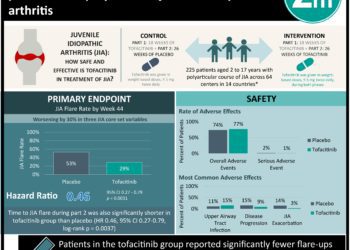Patient Basics: Juvenile Arthritis
Originally published by Harvard Health.
What Is It?
Arthritis involves inflammation of the joints that causes pain and swelling. Although many people believe arthritis is a disease of old age, various forms of arthritis can affect just about anyone at any age. When arthritis occurs in children younger than age 16, it is called juvenile arthritis. Approximately 285,000 children in the United States have some form of the disease.
The most common forms of juvenile arthritis are:
- Juvenile rheumatoid arthritis, also called juvenile idiopathic arthritis – This is the most common form of juvenile arthritis. Juvenile rheumatoid arthritis is thought to be an autoimmune disease, which means that, for unknown reasons, the body’s immune system attacks some of its own tissue the same way it would react against a foreign invader such as a virus or bacteria. In juvenile rheumatoid arthritis, the lining of the joint (called synovial membrane) becomes inflamed and enlarged, limiting movement and causing pain and tenderness. Enzymes released by the inflamed membranes cause further damage by eroding the bone and cartilage. This type of joint and bone damage can cause problems in a growing child. If the growth areas of the bones are affected, the bones may grow at different rates so that one bone may develop abnormally in shape or size. The result could be, for example, that one leg might be permanently shorter than the other.
There are several subcategories of juvenile rheumatoid arthritis, including:
- Systemic onset type, which begins with a whole-body (systemic) reaction, including high fevers; skin rash on the legs, arms and trunk; joint inflammation; and signs of inflammation of other body organs, such as enlarged lymph nodes or lining of the lungs (pleurisy). A child may have one or more episodes of systemic onset juvenile rheumatoid arthritis that eventually disappears, or the condition may persist into adulthood.
- Pauciarticular onset disease, in which fewer than five joints are affected, is the most common form of juvenile rheumatoid arthritis. The large joints – such as knees, elbows, and ankles – are often affected, but usually not the same joints on both sides of the body. For example, the knee on one side may be affected and the ankle on the other. Symptoms include pain, swelling, stiffness, redness and warmth at the affected joint. Children with this type of juvenile rheumatoid arthritis are particularly susceptible to an eye inflammation called iridocyclitis. These children need to be evaluated often by an ophthalmologist, perhaps as often as every three months, because there may not be any symptoms and permanent eye damage can occur even if other symptoms of juvenile rheumatoid arthritis are under control. Treatment for iridocyclitis is highly effective. Many or even most children with pauciarticular onset juvenile rheumatoid arthritis will notice that the disease subsides over time.
- Polyarticular disease, in which five or more joints are affected, usually involves the small joints, such as those in fingers and toes, although large joints can also be affected. Symptoms include the same inflammatory symptoms as other types of juvenile rheumatoid arthritis, along with low-grade fever and bumps called rheumatoid nodules near the affected joints. Typically, the same joints on both sides of the body are affected. Polyarticular juvenile rheumatoid arthritis is more common in girls than in boys, is usually more severe than the other two types, and often leads to long-term joint problems. In 5% to 10% of cases, the antibody called rheumatoid factor can be detected in a blood test, which further classifies the juvenile rheumatoid arthritis as seropositive. Seropositive juvenile rheumatoid arthritis is most like adult rheumatoid arthritis, and often continues into adulthood.
- Juvenile axial spondylo arthritis – This disease involves the large joints of the lower body, particularly the lower back and hips. Key symptoms are lower back pain or stiffness, especially in the morning. The pain improves with exercise. It affects boys more often than girls.
- Reactive arthritis (formerly called Reiter’s syndrome) – This type of arthritis can develop weeks to months after a child has been exposed to certain bacteria, in particular shigella, salmonella or yersinia associated with diarrhea. The disease usually starts suddenly. Key symptoms are fever along with pain and inflammation in several joints, conjunctivitis (eye inflammation) and painful urination.
- Juvenile psoriatic arthritis – This type of chronic arthritis strikes some children who have psoriasis, and seems to have a genetic component. Along with joint pain and inflammation, key symptoms are pitted fingernails, psoriasis and a raised, scaly rash behind the ears, in the area of the navel, along the scalp or other body areas.
- Juvenile systemic lupus erythematosus (lupus) – Although lupus usually does not appear before adolescence, when it occurs in children it is very similar to lupus in adults. This disease can cause inflammation and tissue damage in many areas of the body, especially the skin, joints, blood vessels, brain, heart, muscles or kidneys. The disease often appears in episodes that come and go for no particular reason. Key symptoms include a rash on the cheeks, sensitivity to sunlight, mouth or nose sores, joint pain, seizures or other signs of neurological problems, and chest pain.
Symptoms
Symptoms vary depending on the child and the specific disorder. Common symptoms include:
- One or more joints that are persistently swollen and tender, or possibly red and warm to the touch
- Pain when moving joints, although many young children never complain of pain
- Stiffness or decreased ability to move joints, especially when waking
- Limping
- Joints that look knobby or deformed
- Bent posture or limbs
Other symptoms can include:
- Uneven (asymmetric) growth patterns (one leg longer than the other, for example)
- Blurry vision, eye pain or redness
- Low-grade fever
- Skin rash
- Fatigue
- Irritability
- Chest pain
- General complaints of pain
Diagnosis
Juvenile arthritis is difficult to diagnose because many diseases have similar symptoms, and there is no single test that pinpoints the diagnosis. If your child shows signs of juvenile arthritis, you likely will be referred to a pediatric rheumatologist. The rheumatologist will look at your child’s medical history to find clues. For example, one of the primary diagnostic criteria for juvenile rheumatoid arthritis is joint inflammation that has lasted for at least six weeks. Your doctor may order blood tests to look for antibodies that commonly form in people with some types of arthritis, although these antibodies are often absent in children. X-rays may be done to look for damage to cartilage or, in severe cases, bone. Other tests may also be done to look for other conditions that could explain the symptoms, such as tests for infection; Lyme disease is an infectious cause of arthritis that may affect children and mimic juvenile rheumatoid arthritis.
Expected Duration
Juvenile arthritis usually is a lifelong condition. However, for many people, symptoms gradually lessen or disappear as they enter adulthood.
Prevention
Because no one knows what causes juvenile arthritis, there is no way to prevent it.
Treatment
The main goal of treatment is to control inflammation to stop further damage to the joints, and to control symptoms so that the child can function well. Nonsteroidal anti-inflammatory drugs (NSAIDs) are usually the first medications tried to relieve joint inflammation. They work by decreasing the amount of an enzyme found in affected joints that promotes inflammation. This same enzyme, however, helps to protect the stomach, so NSAIDs often cause stomach irritation and ulcers. Low doses of NSAIDs are available over-the-counter, including ibuprofen (Advil, Motrin and other brand names) and naproxen (Naprosyn, Aleve and others). Celecoxib (Celebrex) is a newer prescription drug, called a COX-2 inhibitor that is thought to be safer for the stomach because it does not have as much of an effect on the enzyme that protects the stomach.
In moderate to severe cases, children with juvenile arthritis may be treated with more powerful medications or a combination of medicines. Corticosteroids (such as prednisone) are fast-acting, anti-inflammatory agents that may be used to stop dangerous inflammation, such as when the lining of the heart has become inflamed (pericarditis) or to stabilize a child in an acute stage of the disease. However, these drugs can have very serious side effects, including weight gain, weakened bones, an increased susceptibility to infections and interference with growth. They usually are prescribed for only a short time. They must be taken exactly as directed.
Other drugs, called disease modifying anti-rheumatic drugs (DMARDs) – such as methotrexate (Rheumatrex and others) – act more slowly, but often provide relief if other medications have failed. These drugs can cause liver damage or other complications, so doctors will carefully monitor blood tests in children taking DMARDs. Other medications may be effective, including hydroxychloroquine (Plaquenil), sulfasalazine (Azulfidine), leflunomide (Arava), azathioprine (Imuran) and cyclosporine (Neoral, Sandimmune). Thalidomide may be effective for certain children with JRA, but care must be taken to avoid pregnancy while taking this drug and it can cause nerve damage.
Newer, injectable treatments, including adalimumab (Humira), etanercept (Enbrel) and tocilizumab (Actemra) were recently approved for juvenile rheumatoid arthritis. Infliximab (Remicade), abatacept (Orencia), anakinra (Kineret), and rituximab (Rituxan) can also be highly effective for some children with juvenile rheumatoid arthritis.
Surgery sometimes is required if joint damage is severe or joint deformity has developed.
Children with juvenile arthritis should be encouraged to maintain as normal a life as possible. Although there may be pain, exercise is important to help the joints keep moving and functioning well. Once symptoms are under control, it’s good for your child to engage in usual play and sports activities. In severe cases, physical therapy may be recommended to keep the joints moving as freely as possible.
Tutoring or special attention from teachers may be needed if the child misses many weeks of school due to illness. Also, counseling might be recommended to help the child deal with the emotional aspects of having a long-lasting (chronic) illness.
When To Call a Professional
Call a health care professional if a child develops fever or rash along with symptoms of arthritis, such as persistent joint pain, swollen joints, limping and limited motion.
Prognosis
Because the symptoms and damage caused by juvenile arthritis can vary greatly, the outlook also varies significantly. Some types of arthritis have periods of flaring up and periods when symptoms subside. Treatment can control symptoms for most people, and many children “outgrow” the illness. However, severe forms of the disease can cause growth problems if the growth plates in the long bones are damaged. Children who are very ill also can miss long periods of school, and joint damage can cause long-term joint problems. In addition, the medications used to treat juvenile arthritis can cause other problems, including stomach ulcers, weakened bones and liver damage.
Additional Info
National Institute of Arthritis and Musculoskeletal and Skin Diseases
Information Clearinghouse
National Insitutes of Health
1 AMS Circle
Bethesda, MD 20892-3675
Phone: 301-495-4484
Toll-Free: 1-877-226-4267
TTY: 301-565-2966
http://www.niams.nih.gov/
Arthritis Foundation
P.O. Box 7669
Atlanta, GA 30357-0669
Phone: 404-872-7100
Toll-Free: 1-800-283-7800
http://www.arthritis.org/
American College of Rheumatology
2200 Lake Boulevard NE
Atlanta, GA 30319
Phone: 404-633-3777
http://www.rheumatology.org/



